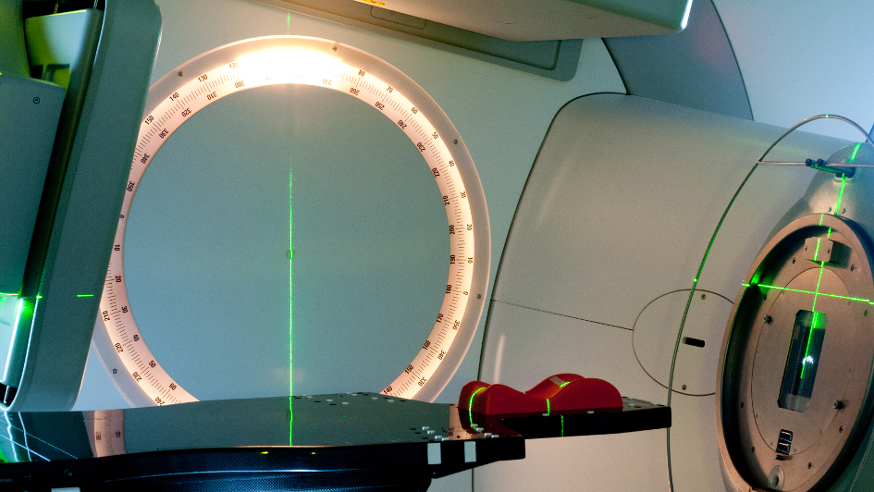
Radiotherapy has an image problem. It has been used to treat cancer for more than 100 years – and some people still think of it as the fairly basic radiation treatment, with high rates of side-effects, that it was in those early years.
But in fact modern radiotherapy is sophisticated and targeted – treating 130,000 people in England alone each year, and curing more patients than all drugs combined.
While the principle behind radiotherapy has remained the same throughout time – killing cancer cells by damaging their DNA – the technique has developed enormously over the years.
Thanks to research carried out here at The Institute of Cancer Research, London, radiotherapy is now more precise and personalised than ever before, with the promise of more exciting advances to come.
Search is our twice-yearly newsletter to supporters. Read our latest news, recent research achievements and interviews with our world-leading scientists and clinicians.
Sign up to search
Leading the way
Our scientists have been at the forefront of radiotherapy research since the founding of our radiotherapy department in the 1940s.
Our researchers pioneered a treatment called intensity modulated radiotherapy (IMRT), working closely with hospital colleagues at The Royal Marsden NHS Foundation Trust.
This high-precision method adjusts the X-ray beam used in radiotherapy to more closely fit the shape of the tumour. It is more effective than conventional radiotherapy and spares the surrounding healthy tissue, easing the side-effects of treatment.
Thanks to our research, IMRT has since become the standard of care in the UK for many types of cancer including prostate cancer and head and neck cancer.
In fact, the development of IMRT was recently highlighted by the National Institute for Health Research as one of 70 research discoveries that have transformed health and care in the NHS over the last 70 years.
Targeting radiotherapy in real time
Since then, we’ve been continuing to make improvements to the way radiotherapy is targeted.
We worked with The Royal Marsden on the development of image-guided radiotherapy (IGRT), which adjusts the radiotherapy beam according to feedback from a scanner that monitors patients’ movements during their treatment.
And, last year, we took this research to the next level, working with The Royal Marsden to open the UK’s first MR Linac unit, featuring a new type of radiotherapy machine.
The MR Linac precisely locates tumours, tailors the shape of X-ray beams in real time, and accurately delivers doses of radiation even to tumours that are moving, for example as a patient breathes.
Soon to be tested for the first time in patients, the machine should transform radiotherapy by targeting the treatment more precisely than ever before.
Fewer, stronger doses
But improved precision is only part of the puzzle. To make radiotherapy kinder for patients, ICR researchers are also reducing the number of doses needed.
The START clinical trials, led by Professors Judith Bliss and John Yarnold, found that a shorter course of radiotherapy – with fewer, stronger doses delivered over three weeks rather than five – is as good as a longer course for treating breast cancer.
CHHiP, a similar study in prostate cancer led by Professor David Dearnaley, has also found a shorter course of prostate cancer radiotherapy is as effective as the current standard treatment, and is changing the standard of care across the UK.
Both trials make radiotherapy more convenient and less tiring for patients – and are already saving the NHS tens of millions of pounds each year.
Combination treatments
Our researchers are also looking at ways to improve the effectiveness of radiotherapy in the lab – for example by combining it with other treatments.
The ICR’s Professor Kevin Harrington recently showed that a triple therapy of chemotherapy, radiotherapy and a targeted drug could be an effective new cancer treatment. The combination killed more head and neck cancer cells in the laboratory, and was more effective at treating tumours in mice, than any of the therapies individually.
His colleague Professor Alan Melcher showed that a modified virus could be used to target cancer cells in the brain – research that has already been adapted into a clinical trial, in which patients will be given the virus in combination with the standard treatment of radiotherapy and chemotherapy.
And, earlier this year, Professor Harrington revealed that gene therapy could protect healthy tissues from the harmful side-effects of radiotherapy. By using a modified virus to deliver extra copies of the SOD2 gene, his research helped to limit the stress response to the harmful particles released by radiotherapy.
Support our work to refine radiotherapy
Developing kinder, more precise radiotherapy is just one area of our research made possible with the help of our supporters. Together we have made major progress in cancer research, but so much more needs to be done.
You can learn more about the ICR and our cancer research discoveries, by signing up to our bi-annual e-newsletter, Search. In it, you can read about our latest research, our brilliant fundraisers and opportunities to support our work so that we can continue to defeat cancer
comments powered by